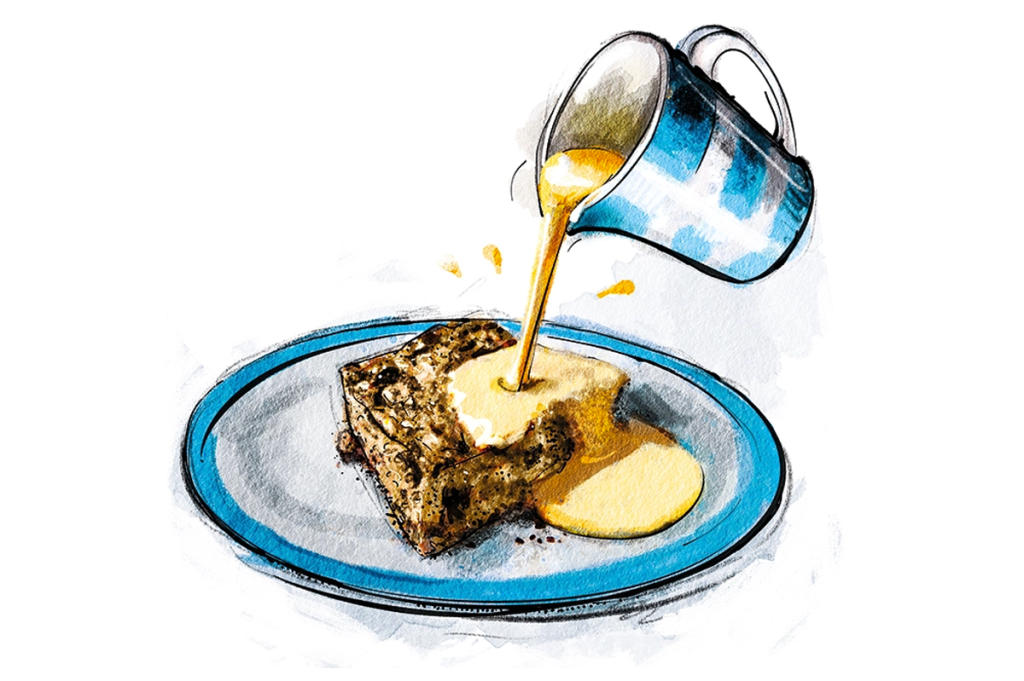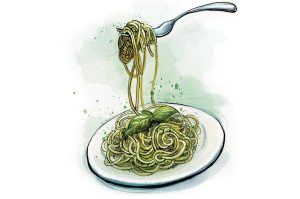I am incapable of throwing anything away in the kitchen. In my fridge, there must be at least half a dozen pots of bits and bobs, dishes of leftovers and scraps. In my freezer, a bag of parmesan rinds has filled slowly, each intended to be chucked into a pot of soup or stew to bring savory depth, and there’s even an optimistic box of pea pods that I’m convinced I will one day turn into a stock to make an authentic risi e bisi.
All await a future transformation, some kitchen wizardry that will rescue something that is a little past its best. Although I confess I sometimes find myself buying a bunch of ingredients just to use up something I’ve squirreled away, or plain forgotten about and left a touch too long. But I think it’s a cook’s instinct to try to save produce, and there is a true satisfaction (and economy) in repurposing what would otherwise end up in the bin.
Many of the most beloved British puddings have been borne out of this waste-not-want-not mentality: rice pudding uses up an excess of milk, while posset turns tired cream into a beautiful citrusy, zingy set custard, and treacle tart requires stale breadcrumbs. Queen of puddings uses up both breadcrumbs and milk, making them go further with a layer of jam and another of meringue. And apple charlotte and summer pudding both use slices of stale bread for structure and to soak up the flavor of the fruity filling. Rather a lot of these puddings use stale bread, actually, which I suppose is unsurprising when we consider quite how much of a staple bread has been in Britain, and how quickly it stales.
Necessity is the mother of invention — and it’s hard to think of a better rebirth than stale heels of bread turned into something sweet and fragrant and, as is the nature of puddings, slightly celebratory.
Bread pudding is a particularly old example of this kind of kitchen transformation. Its earliest incarnation dates back to at least the Middle Ages, when scraps of bread would be collected in the kitchen — and then soaked with water, squeezed out, mixed with sugar and spice and baked.
Unsurprisingly, bread pudding is often conflated with bread and butter pudding, but the two are quite distinct, and shouldn’t be confused. Where bread and butter pudding is made with slices of bread and baked in custard, bread pudding uses crumbs, which are soaked in milk until they form a thick, homogenous batter, and is then mixed with sugar and eggs and butter, and studded with sultanas and currants and little chunks of zest, with demerara on top for crunch. Once baked, its texture depends on the temperature you serve it at: warm, and it is more of a pudding, squidgy and custardy, but left to cool, it can be sliced like a cake.
While bread and butter pudding has been fancied up in every conceivable way — using increasingly richer breads (brioche, panettone, even croissants) and all sorts of additions (my mother used pineapple jam; Jamie Oliver has a dark chocolate and marmalade version) — bread pudding is comparatively simple. In fact, the plainer the bread the better: I often just use simple white sliced bread, although wholemeal brings a depth of flavor, and a proportion of rye breadcrumbs in the mixture is fantastic.
It tastes suitably old-fashioned: heavily spiced and packed with dark sugars and dried fruit. In fact, I think bread pudding is the perfect bridge from fall to winter, tasting almost Christmassy, without actually having all the festive bells and whistles. But if you’re ready to go the whole Christmas hog, you can follow Delia Smith’s example: she serves her bread pudding with brandy cream.
Serves twelve Takes forty-five minutes’ preparation (including soaking) Bakes one hour fifteen minutes
- 12 oz breadcrumbs
- 15 fl oz whole milk
- 2 eggs
- 3½ oz light brown muscovado sugar
- 1 tbsp mixed spice
- 2⅔ oz melted butter
- 1 lemon, zested
- 12 oz mixed fruit and zest
- nutmeg, for grating
- 1 tbsp demerara sugar
- Place the breadcrumbs into a large bowl and pour the milk over the top. Leave to soak for thirty minutes
- Meanwhile, line an eight-inch square cake tin with baking paper, and preheat the oven to 350°F
- Mix together the eggs, sugar, butter, mixed spice and lemon zest, and stir these through the soaked breadcrumbs. Fold the mixed fruit into the mixture, then tip it all into the prepared tin. Generously grate nutmeg over the top of the mixture, then sprinkle evenly with the demerara sugar
- Bake for thirty minutes until the pudding is slightly puffed, dark golden, and firm to the touch. Serve warm with custard, or leave to cool and slice into squares
This article was originally published in The Spectator’s UK magazine. Subscribe to the World edition here.





















